A complete collection of four common swimming styles
First, breaststroke formula
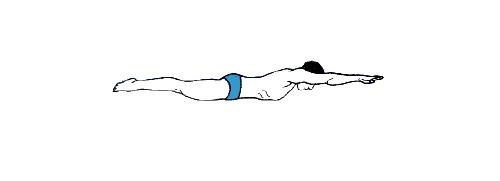
1, one of the breaststroke formula (total formula):
(1) Breaststroke kicks like frogs, pushing back and sliding forward. Close your legs and feet with your hips, and your knees are shoulder-width apart.
Slowly retract your legs while retracting, and turn your toes to both sides. Push the water back hard and float your feet together for a while.
(2) The breaststroke arm strokes symmetrically, and the peach stroke strokes sideways. Bend your wrists with both hands to catch the water, and bend your arms and elbows back.
Row under your shoulders, stop quickly, and clamp your elbows in hard. Stretch your hands forward in parallel, straighten and relax and move forward.
(3) Attention should be paid to breaststroke coordination, and the legs and arms should breathe properly. The two-arm paddling legs are relaxed, and the legs are closed at the same time.
Stretch your legs forward and push the water, and slide your arms and legs straight for a while. Pull your head up slowly, slide your hand and exhale slowly.
(4) Two arms are paddling at the same time, and the head is raised and inhaled closely. Close your legs, turn your ankles to catch water, and exhale water with your nose.
Close your hands and slowly retract your legs, and stretch your arms forward before kicking. This kind of cooperation should be kept in mind, and coordination should be learned.
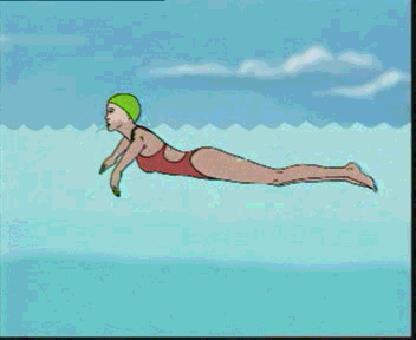
2. The second formula of breaststroke (four-word key):
Break up and press the wrist, pull the fiber with double anchors, hold the water with high elbows, and turn your hands and shoulders. The stem neck comes out of the water, the snake waist drags the hip, the knees are lowered, and the feet are everted. Into the water, hide your head, gather your arms and hide your shoulders, turn your inner ankle backwards, and turn down the pedal clip. The front is low and the back is high, the sand slides and stretches, the legs are stretched and the abdomen is closed, and the water rises.
Interpretation of the four-word key of breaststroke;
Breaking up and pressing the wrist is the preparatory action to start paddling, and it is also the key to make paddling effective. You have to press your hands down into a dovetail shape before you can enter the drawing stage.
Different from the traditional wiper stroke, [double anchor drawing] tends to be similar to the butterfly stroke, emphasizing the stroke mode of resistance propulsion. When the hands are pressed down into a Y- shape, the hands are like two anchors stuck in the water, and they are pulling at an accelerated speed until the elbows are completely out of sight. The power of pulling makes the body jump out of the water under the guidance of the head.
When holding water with high elbows, the elbows should always be higher than the hands to pull water, so that the hands and forearms form a paddling surface together, and the body is pulled forward until the elbows are always in a state of tension.
[Stem neck water] is to say that water should not be held high, and the neck ridge should be kept in a straight line, rising and falling together.
[snake waist dragging hip] means that when pulling up, the waist and back must be arched, and then they can rush forward and rebound. The back bow should be erected like a cobra, ready to attack; The forward bounce is like a snake’s attack, and it is asserted. The former uses the waist, and the latter abdomen, falling together.
[Fold your knees]. When folding your legs, you just need to fold your knees and turn your legs into a [W] shape.
[Hip valgus] means that toes should point to both sides. Turn your feet from [the outer figure of eight] to [the inner figure of eight] and whip them backward and downward.
[Hidden head in water] means to hide your head after entering the water, and to be completely immersed in the water, preferably below the horizontal line of your body.
[Close your arms and hide your shoulders], keep your arms as close as possible, as if to squeeze your head from between your arms.
[medial malleolus backward], the medial malleolus should be facing the rear, which is the initial phase of kicking and the key to the success or failure of the kicking process.
[Pedal clamp downward rotation], the folding is upward rotation and the pedal clamp is downward rotation; Spin up until the toes point to both sides, and spin down until the soles of the feet are closed.
[The front is low and the back is high, and the sand slides and stretches] is a sliding phase when entering the water, until [breaking up and pressing the wrist], during which the feeling is as smooth as falling down from the sand mountain with head down; In the meantime, it seems that all the discs between cones have been released.
[Stretch your legs and abdomen, float to the surface], which means that in the second half of the slide, you should prepare for the initial position of the subsequent stroke [break up and press your wrist] and approach the surface of the water with inertia. If the body is still far from the water, [drawing fiber] will have to be replaced by pressing water, and the forward power will be halved. Therefore, when [sliding sand stretching], the body can neither bend back nor relax, but must [stretch the legs and abdomen] and still be streamlined, using the buoyancy of the chest to float to the surface at a small angle.
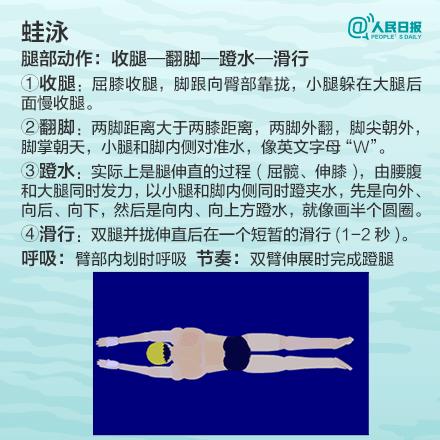
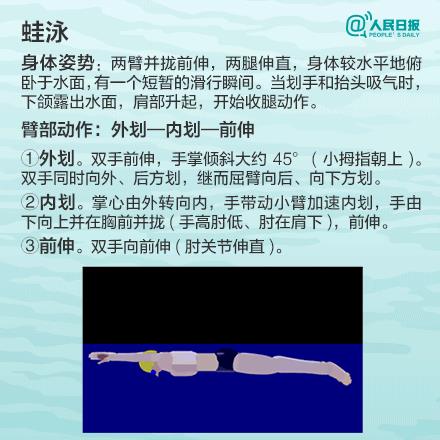
3. The third formula of breaststroke (detailed formula):
(1) Introduction of breaststroke
The legs are curved to hold water, and the mouth and nose are used to exhale in the water.
Paddling combined with slow leg retraction, two arms stretched forward and then pedaled,
The breaststroke posture is like a frog, and the arms stroke symmetrically on the side.
Slowly retract your legs while retracting, and turn your feet outwards to aim at the water.
Push your legs back and hold the water, and slide your arms and legs straight for a while.
Push the water backwards in an arc, straighten and float together for a while.
(2) Leg movements
Bend your knees slowly close to your hips, and the distance between your knees is shoulder-wide.
The rower’s legs don’t move, and the legs are closed after the hand is closed.
Slowly retract your legs while retracting, and flip your feet to both sides.
Stretch your arms first, then kick, and straighten your arms and legs for a while.
Push the water back hard and float your legs together for a while.
(3) arm movements
Press the water with both hands to the outside, raise your elbow and bend your arm and row back.
The parting is slightly wider than the shoulder, and the elbow is turned inward and stretched forward.
Pull under the shoulder and stop. Pull and stop.
Draw your arms back from side to side, straighten and float together for a while.
(4) Breathing action
When holding water on your arms, raise your head slightly and suck the air.
Lower your head and stretch your arms and exhale slowly. Row your arms, raise your head, and breathe in.
When your arms slide forward, your nose and mouth slowly exhale.
(5) Coordination of breathing with leg and arm movements
Pull your arms apart, raise your head and inhale closely,
This method is called late breathing, which is perfect for reducing resistance.
(6) Complete coordination action
Two arms paddling without moving legs, closing hands and closing legs at the same time,
Stretch your hand halfway to pinch the water, stretch your arm and kick for a while,
Pull your head up and suck in half, and reach out and shout slowly.
Second, the freestyle formula
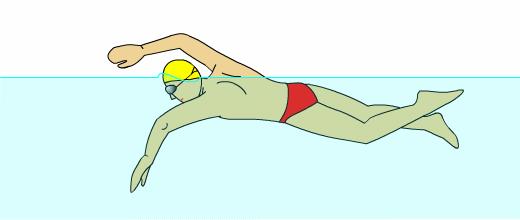
1. One of the freestyle formulas (general formula):
(1) freestyle body must be horizontal, with arms crossed forward. Put your fingers into the water before your shoulders, and stretch your shoulders and bend your wrists to catch the water.
Bend your elbows and palms to the water, and do the "S" route correctly. Finish paddling to the hip, turn your shoulders and lift your elbows to get out of the water quickly.
(2) The body is prone and streamlined, and the water appears in the brain. Stroke with both hands, and alternately hit your legs six times.
Exhale slowly under the shoulder, push the water, lift the elbow and turn to suck. The legs and arms are breathing well, and the freestyle speed is incredible.
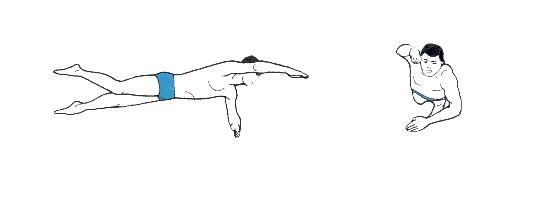
2. The second formula of freestyle (four-word key):
Wipe the head on the water, the neck ridge is flat, the chin converges, and breathe. The whole body should be rigid, the waist and abdomen should be tense, the logs should roll, and the umbilicus should look at both sides. Put your arm into the sleeve, turn your shoulder into the frame, draw straight close to your body, pull soft and push hard. The thigh is clamped, the calf is like a spring, and the ankle is relaxed, with relaxation and tension.
Interpretation of four key words of freestyle;
[Wipe your head on the water]. When swimming in, try to immerse your head in the water as much as possible, and the part exposed on the water should not exceed 1/4 of your head, so that your head can slightly brush the water.
[The neck and spine are horizontal]. The cervical spine and spine should be pulled into a straight line and kept horizontal.
[chin convergence], look at the bottom of the pool, the chin should be retracted and squeezed into a double chin.
[Breathe Moang], when breathing, the head should roll with the extension line of the neck ridge as the axis, and it is forbidden to breathe with the head held high.
[Perfect], imagine the whole body, especially the trunk, like a hard and full torpedo.
[Tension in the waist and abdomen], the waist and abdomen should be tightened, and the abdomen should be lifted.
[Log Rolling] means that the body should be like a torpedo and a log, and it should roll on the long axis as a whole with rhythm.
[Look at both sides of the navel], the rolling angle is just right for the navel to see both sides, or the audience on both sides can just see the swimmer’s navel.
[Put your arm into the sleeve]. When you enter the water, you should put your hand forward as far as possible, as if it were in a slender and soft silk sleeve.
[Turn your shoulders into the frame]. Imagine that your body is going through a narrow frame in the front, so the lateral amplitude of the action should be as small as possible.
[Close-body straight stroke], the stroke hand should be under the long axis of the body, close to the body and walk in a straight line.
[Pull soft and push hard], start accurately, grasp the water steadily, and gradually accelerate the stroke, pushing the water under your feet, but don’t bump into your thighs.
[Legs clamped], when kicking, the thighs can’t be separated, and it plays the role of connecting the preceding with the following, that is, transmitting the strength of the hip to the toe.
[The calf is like a spring], the calf should be elastic, and the range of kicking up and down should be controlled at about one foot.
[Relax your ankles]. Your ankles should follow the pressure of water and move with the trend, just like the tail of a fish, so don’t be stiff. Legs from hip to toe should be loose and unremitting, tight and not stiff, and the water should be strong and well-controlled.
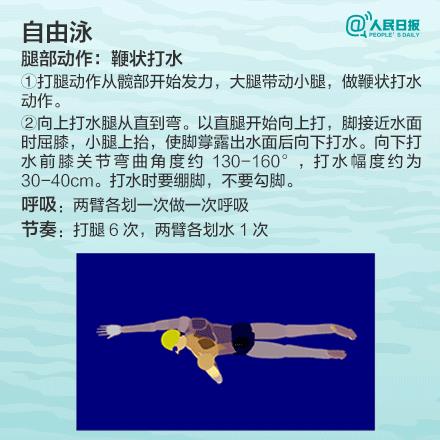
3. The third formula of freestyle (detailed formula):
(1) Introduction of crawl (freestyle)
Crawl, such as crawling in water, alternately paddling with both arms,
Keep your body steady and lie prone in the water, crossing your arms and rowing in turn.
Keep your body level, and your legs are whipped up and down.
Whip your legs up and down, breathe slowly and suck quickly and row forward.
(2) Leg movements
The thigh forces the calf, and the legs alternately whip the water.
The thigh is forced to bring the calf, and the legs alternate to fetch water.
Draw water shallowly and quickly, and relax your ankles slightly and turn inward.
(3) arm movements
The palm enters the water first before the shoulder, and the arm slides down to hold the water.
Move the arm, relax the shoulder and insert it forward, and aim the palm of the forearm at the water.
The power of bending the arm and paddling is great, and turning the shoulder and lifting the elbow can get out of the water quickly.
Speed up along the center line, and alternate strokes with both arms.
The two arms cooperate with each other to paddle hard, and the thrust is gradually increased after holding forward.
(4) Breathing action
Row to the shoulder and exhale slowly, push the water, lift the elbow and suck up.
Breathe out slowly with your head in the water, turn your head and open your mouth to inhale quickly.
(5) Coordination of breathing with leg and arm movements.
Paddle with both hands, and hit the legs at will.
Hit two, hit four or hit six, or suck left or right once.
(6) Body position
The body is prone and streamlined, and the chest is slightly shoulders high.
The water is flush with the forehead and the brain is exposed, and the hips and abdomen should be flat and eyes open.
(7) Stroke arm type
There are three types of arm strokes, namely, front crossing, middle crossing and rear crossing.
It is old and long to travel before making friends, and the effect of making friends after making friends in China is good.
Third, backstroke formula
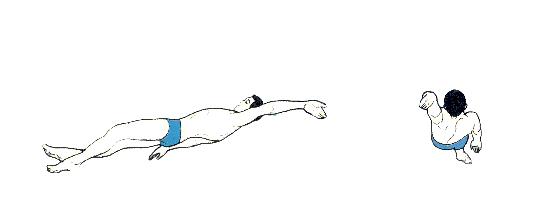
1. One of the backstroke formulas (general formula):
(1) Put your hand into the water on the shoulder extension line, and stretch your arms to hold the water. The palm bends to the water, and the stroke route should be kept in mind.
Push the water behind the palm and forearm, and push the thumb out first. Turn your shoulders and lift your arm straps, and relax your arm movement in the air.
(2) Backstroke coordination is easy, with six kicks and two arms. Breathe two strokes at a time, and breathe in with your mouth.
Push the water and exhale quickly, turn your shoulders and move your arms to hold your chest. Suck your legs three times, kick them three times and exhale.
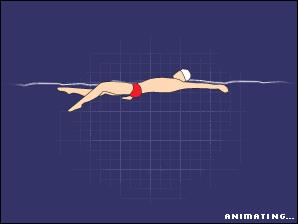
2. The second formula of backstroke (four-word key):
The water overflows the cheeks, the nose refers to the blue sky, the breath sinks and floats, and the side slip does not turn.
Shoulder-lifting and hand-pulling, double-spoke rotation, sharp blade to cut water, arm extension to send hips.
With water in the palm of your hand, bend your elbow and collapse your shoulders, push the front line, caress your legs and stick to the edge.
Straighten your ankles, bend your feet inward, kick up and press down, and wave your toes.
Interpretation of the four-word backstroke;
[Water overflows your cheeks]. When swimming backstroke, you should straighten your head, neither accept your chin nor lean back, so it is advisable to let the water flow through your cheeks.
[Nose refers to the sky], although the body rolls, the head should not rotate with it, and always face upwards.
[Breathe, sink, suck and float], because the front of the body will be a little ups and downs after the hand enters the water, so breathing should be carried out rhythmically to avoid choking.
[Don’t turn when sideslip], when rolling sideslip, the head can’t rotate left and right.
[Lift the shoulder and draw the hand], after the hand strokes, it is necessary to lift the shoulder to complete the water; From shoulder-elbow-wrist-finger, out of the water in turn, use the big joint to drive the small joint, and pull the arm out of the water.
[Double spoke rotation], the arms are like spokes of a wheel, alternating at an angle of 180 degrees. The outer side of the little finger is called the [blade], and [cutting the water with a sharp blade] means that the little finger leads into the water, so that the upper arm is close to the cheek, and the arm is extended with the hip. Follow up when the little finger enters the water.
[reaching out to send hips], that is, something that seems to stand on tiptoe to reach high enough; And the [torque] of turning the hip comes from the downward leg press on the other side.
[Horizontal palm with water] is the first phase after the hand enters the water, that is, the palm is horizontal in the forward direction; Otherwise, if you don’t bring water with you, paddling will have no effect.
[Elbow down and shoulder collapse], start paddling, especially when paddling to the shoulder line, the elbow tip should be vertical to the bottom of the pool, and the shoulder should sink into the water, so that the paddling route is closer to the vertical plane of the longitudinal axis of the body.
[Push the first line], push the water all the way back. When the rower crosses the shoulder line, turn his palm to the bottom of the pool to press the water.
[Touching the leg and sticking the edge], after pressing the water, the arm should be close to the body, and the tiger’s mouth should slightly wipe the thigh.
[Ankle Straightened], both supine and prone kicking require ankle straightening, which is the key to effective water fetching.
[Feet are flexed inward], because the hips should roll about 45 degrees, in order to prevent the feet from crossing too wide when fetching water, each other can meet the water flow driven by kicking on the other side, so as to obtain greater propulsion power, so it is necessary to bend inward slightly.
[Kick up and press down], because the upper kick is limited by the knee joint, the lower press has a wide degree of freedom, so it is necessary to limit the amplitude. It is better for the waves to roll at the toe, and it is subject to no splash, that is, [Wave rolls the toe].
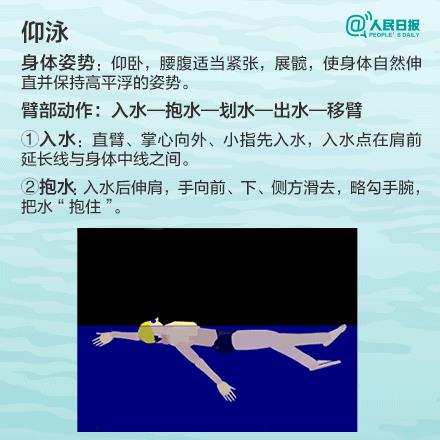
3. The third formula of backstroke (detailed formula):
(1) Introduction of backstroke
There are two kinds of backstroke postures, both of which are backstroke.
Lying on your back in the water naturally, your abdomen is slightly contracted and your chest is slightly expanded.
The reverse frog backstroke has been eliminated, and the reverse crawl backstroke has the upper hand.
Kick the water with your legs up and down, and paddle with your arms in turn.
(2) Leg movements
The thigh is forced to take the hip as the axis, and the downward pressure and upward kick are alternately played.
Exert your strength with your thighs and kick hard with your calves.
Knees and toes don’t get out of the water, and the movements should be consistent and natural.
The toes are inclined inward, and the whips alternate.
(3) arm movements
The shoulder extension line is cut in by the outside hand, and the arm is extended to hold the water and the palm is facing the water.
Water enters the side of the air moving arm. Bend your arms and sink your elbows at the water,
The curved arm paddles to the waist, and the forearm palm pushes and presses.
Accelerate backward and push the water quickly, and take turns paddling with both arms.
Pull and push the body to row sideways, press first and then lift the water quickly,
Lift the shoulder to drive the upper forearm, move forward in the air and extend the arm forward.
(4) Breathing action
It’s easier to breathe in backstroke. Breathe in through your mouth instead of your nose.
Push underwater and exhale quickly, lift your shoulders and move your arms to hold your chest,
Take a breath after kicking three times, and exhale after kicking three times.
(5) Coordination of breathing with leg and arm movements
Six kicks, two arms, one breath and two strokes,
Three kicks, one arm, and so on.
Four, butterfly stroke formula
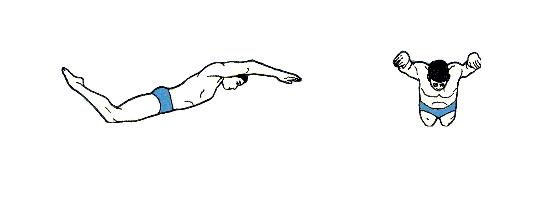
1, one of the butterfly formula (total formula):
(1) Butterfly kicks like a dolphin, whipping water with his belt and legs. Draw water with your legs together and remember your hips.
Turn your ankles inside your legs to relax, close your legs, lift your hips and straighten your waist and abdomen.
(2) The butterfly moves its arm like a butterfly, lowering its head and sending its shoulder arm forward. Reach into the water, spread your shoulders and grab the water, with your high elbow paddling and your arm bending inward.
Aim your hands at the water at the same time, and push the water hard with both arms. Lift your elbows quickly after pushing the water, and spread your wings with your arms out of the water.
(3) Push the water head with both arms to lift, and inhale quickly and lower the head. Push the water and hit your legs at the same time, and put your feet together to exert your strength.
Go into the water and whip your legs twice. Don’t forget to rotate your feet internally. Breathe out slowly with your arms in the water, and move forward like waves.
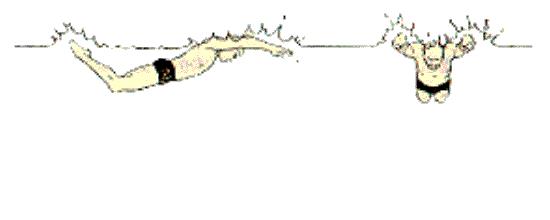
2. The second formula of butterfly stroke (four-word key):
Chest and armpit pressure, elbow tips apart, abdomen and buttocks, iron law of entering water. Side pressure stroke, internal sweep force, tiger’s back rising, back swing arm. Shrug your shoulders and swing your wrists, move your wings leisurely, take and put down gently, and your elbows are high and low. Legs rise and fall, originating from the back of the waist, snake-shaped, and the first item is the flag.
Interpretation of the key words of butterfly stroke;
[Chest and armpit pressure] is the first step to start the body wave state in butterfly stroke, and its amplitude depends on the flexibility of the shoulder blade. If the chest and armpits are not pressed down, it is difficult to get up with elbows, and it is impossible to hold water with high elbows.
The purpose of [elbow tip separation] is to ensure that the water is cut under the thumb, the water is held with the elbow high, and the side pressure is connected. When the front half of the body is pressed down, it will inevitably lead to the core part lifting up, showing the trend of [abdomen and buttocks], which is a counterweight to the kicking of the back half. This is the law of chain transmission of the body, so it is called [iron law of entering the water].
[Side pressure stroke] is the initial phase of stroke, which is the same as [breaking up and pressing the wrist] in breaststroke.
[Internal scanning force] is the later stage of pulling water phase, and it is also the stage of starting to exert force. In the process of pulling water, with the surge of water flow and the balance of legs, the body leaps up and forward, and the water comes out with the shoulder as the highest point of rising, that is, [the tiger’s back rises].
In order to push the water phase, the [swing arm] must accelerate the whole process, in which [swing arm] refers to the sudden return when the momentum reaches the maximum, that is, the arm returns at the original speed before pushing the water to the crotch; This not only pushes the water into place, but also allows the arm to bounce out of the water by pushing.
When moving your arms, you should [shrug your shoulders and swing your wrists, and move your wings leisurely], and throw your arms forward as far as possible, as far as possible from the water entry point, so as to fully drive your body. [Shrugging your shoulders, swinging your wrists and moving your wings leisurely] starts with [swinging your arms back], and the depth of your kung fu can be seen from the whole process of [moving your arms]. The butterfly stroke is the only stroke named after the feature of [moving the arm], so four sentences are used in the formula to describe the whole process of moving the arm: [shrug your shoulders and swing your wrists, move your wings leisurely, take and put down gently, and your elbow is superior and low], among which [taking and putting down gently] is particularly difficult, and [taking] and [putting] can reflect the control ability of your waist and abdomen when leaping.
[Legs rise and fall from the waist], the main power source of butterfly swimming is the chest, followed by the waist, and then the legs. Therefore, when playing butterfly leg, you need to forget the leg, so that the vibration of the chest can be naturally transmitted to the toe. When the chest is pressed down, the forehead is forward and the top of the head is close to the water; When the shoulders are lifted, the forehead is still forward and the hips are close to the water.
[Snake-shaped wave, the first item is the flag], which means that the butterfly looks like a dolphin and a snake eel from side to side. From beginning to end, all joints of the trunk and legs participate in the jitter. Bow your head when you come out of the water, lift it slightly when you enter the water, and always rush to the other side with your head, guiding the whole body forward like a flagship, that is, [the first item is the flag].
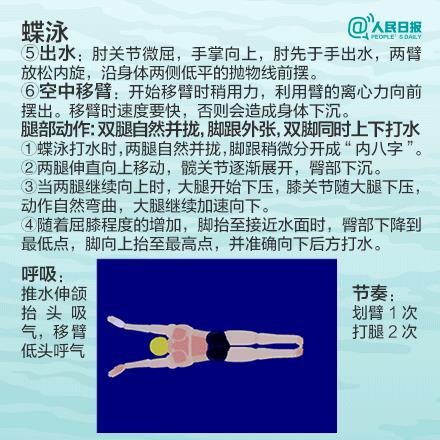
3. The third formula of butterfly stroke (detailed formula):
(1) Introduction of butterfly stroke
Butterfly swimming is like flying in butterfly water, whipping the water with your legs together,
Lie on your stomach horizontally to streamline, lower your head and move your arms forward.
Both arms are paddling at the same time, imitating dolphins flying in waves.
Waves draw water, push hands to suck, stretch your chest, lift your hips and waist to exert strength.
(2) Trunk and leg movements
Hips sink to straighten the waist and abdomen, legs move up and legs bend,
Retract your legs, lift your hips and waist, and your thighs drive your calves to kick.
(3) arm movements
Bow your head and send your shoulders forward, stretch your shoulders and hook your hands to catch the water.
The arms are wider than the shoulders when entering the water, and the shoulders should be extended when entering the water.
Bend your arms inward and paddle hard, push the water and lift your elbows to get out of the water quickly.
Do not separate your arms from each other when holding water, and row with the front wide and the back wide to accelerate the row.
(4) Breathing action
Breathe slowly with your arms in the water, push the water, stretch your neck and look up.
(5) Breathing is coordinated with leg and arm movements.
The butterfly position is not fixed, and the trunk waves move forward.
Kick your arm into the water for the first time, and then kick it under your chest.
The legs are combined like whipping, and the waist, abdomen and legs vibrate in turn.
Lower your head and stretch your arms to exhale slowly, accelerate the push of water and raise your head to suck.
Five, four common swimming methods of four-word tips summary
1. Breaststroke: break up and press the wrist, pull the fiber with double anchors, hold the water with high elbows, and turn your hands and shoulders. The stem neck comes out of the water, the snake waist drags the hip, the knees are lowered, and the feet are everted. Into the water, hide your head, gather your arms and hide your shoulders, turn your inner ankle backwards, and turn down the pedal clip. The front is low and the back is high, the sand slides and stretches, the legs are stretched and the abdomen is closed, and the water rises.
2, crawl: the head rubs the water, the neck ridge is flat and long, the chin converges, and the air is ventilated. The whole body should be rigid, the waist and abdomen should be tense, the logs should roll, and the umbilicus should look at both sides. Put your arm into the sleeve, turn your shoulder into the frame, draw straight close to your body, pull soft and push hard. The thigh is clamped, the calf is like a spring, and the ankle is relaxed, with relaxation and tension.
3, backstroke: the water overflows the cheeks, the nose refers to the blue sky, the breath sinks and floats, and the side slips. Shoulder-lifting and hand-pulling, double-spoke rotation, sharp blade to cut water, arm extension to send hips. With water in the palm of your hand, bend your elbow and collapse your shoulders, push the front line, caress your legs and stick to the edge. Straighten your ankles, bend your feet inward, kick up and press down, and wave your toes.
4, butterfly stroke: chest and armpit pressure, elbow tips apart, abdomen and hips, into the water iron law. Side pressure stroke, internal sweep force, tiger’s back rising, back swing arm. Shrug your shoulders and swing your wrists, move your wings leisurely, take and put down gently, and your elbows are high and low. Legs rise and fall, originating from the back of the waist, snake-shaped, and the first item is the flag.